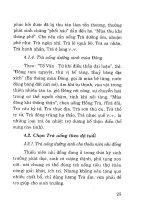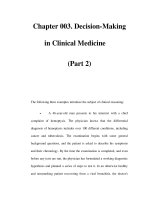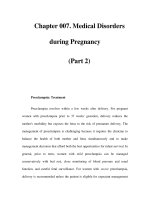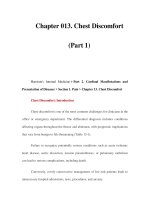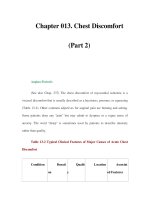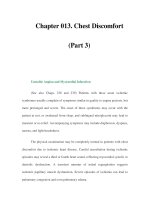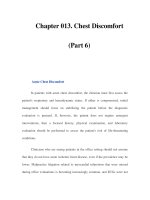Chapter 013. Chest Discomfort (Part 2) pdf
Bạn đang xem bản rút gọn của tài liệu. Xem và tải ngay bản đầy đủ của tài liệu tại đây (23.64 KB, 9 trang )
Chapter 013. Chest Discomfort
(Part 2)
Angina Pectoris
(See also Chap. 237) The chest discomfort of myocardial ischemia is a
visceral discomfort that is usually described as a heaviness, pressure, or squeezing
(Table 13-2). Other common adjectives for anginal pain are burning and aching.
Some patients deny any "pain" but may admit to dyspnea or a vague sense of
anxiety. The word "sharp" is sometimes used by patients to describe intensity
rather than quality.
Table 13-2 Typical Clinical Features of Major Causes of Acute Chest
Discomfort
Condition Durati
on
Qualit
y
Location
Associat
ed Features
Angina More
than 2 and less
than 10 min
Pressu
re, tightness,
squeezing,
heaviness,
burning
Retroster
nal, often with
radiation to or
isolated
discomfort in
neck, jaw,
sh
oulders, or
arms—
frequently on
left
Precipita
ted by exertion,
exposure to
cold,
psychologic
stress
S
4
gallop
or mitral
regurgitation
murmur during
pain
Unstable
angina
10–20
min
Simila
r to angina
but often
more severe
Similar to
angina
Similar
to angina,
but
occurs with low
levels of
exertion or
even at rest
Acute Variabl Simila
Similar to
Unreliev
myocardial
infarction
e; often more
than 30 min
r to angina
but often
more severe
angina
ed by
nitroglycerin
May be
associated with
evidence of
heart failure or
arrhythmia
Aortic
stenosis
Recurr
ent episodes
as described
for angina
As
described for
angina
As
described for
angina
Late-
peaking systolic
murmur
radiating to
carotid arteries
Pericarditis Hours
to days; may
be episodic
Sharp
Retroster
nal or toward
card
iac apex;
may radiate to
left shoulder
May be
relieved by
sitting up and
leaning forward
Pericardi
al friction rub
Aortic
dissection
Abrupt
onset of
unrelenting
pain
Tearin
g or ripping
sensation;
knifelike
Anterior
chest, often
radiating to
back, between
shoulder blades
Associat
ed with
hypertension
and/or
underlying
connective
tissue disorder,
e.g., Marfan
syndrome
Murmur
of aortic
insufficiency,
pericardial rub,
pericardial
tamponade, or
loss of
peripheral
pulses
Pulmonary Abrupt Pleurit Often Dyspnea
embolism
onset; several
m
inutes to a
few hours
ic
lateral, on the
side of the
embolism
, tachypnea,
tachycardia,
and
hypotension
Pulmonary
hypertension
Variabl
e
Pressu
re
Substerna
l
Dyspnea
, signs of
increased
venous pressure
including
edema and
jugular venous
distention
Pneumonia
or pleuritis
Variabl
e
Pleurit
ic
Unilateral
, often localized
Dyspnea
, cough, fever,
rales,
occasional rub
Spontaneous
pneumothorax
Sudden
onset; several
Pleurit
ic
Lateral to
side of
Dyspnea
, decreased
hours pneumothorax
breath sounds
on side of
pneumothorax
Esophageal
reflux
10–60
min
Burni
ng
Substerna
l, epigastric
Worsene
d by
postprandial
recumbency
Relieved
by antacids
Esophageal
spasm
2–30
min
Pressu
re, tightness,
burning
Retroster
nal
Can
closely mimic
angina
Peptic ulcer
Prolon
ged
Burni
ng
Epigastri
c, substernal
Relieved
with food or
antacids
Gallbladder Prolon Burni Epigastri
c, right upper
May
disease ged ng, pressure quadrant,
substernal
follow meal
Musculoskel
etal disease
Variabl
e
Achin
g
Variable Aggravat
ed by
movement
May be
reproduced by
localized
pressure on
examination
Herpes
zoster
Variabl
e
Sharp
or burning
Dermato
mal distribution
Vesicula
r rash in area of
discomfort
Emotional
and psychiatric
conditions
Variabl
e; may be
fleeting
Variab
le
Variable;
may be
retrosternal
Situation
al factors may
precipitate
symptoms
Anxiety
or depression
often detectable
with careful
history
The location of angina pectoris is usually retrosternal; most patients do not
localize the pain to any small area. The discomfort may radiate to the neck, jaw,
teeth, arms, or shoulders, reflecting the common origin in the posterior horn of the
spinal cord of sensory neurons supplying the heart and these areas. Some patients
present with aching in sites of radiated pain as their only symptoms of ischemia.
Occasional patients report epigastric distress with ischemic episodes. Less
common is radiation to below the umbilicus or to the back.
Stable angina pectoris usually develops gradually with exertion, emotional
excitement, or after heavy meals. Rest or treatment with sublingual nitroglycerin
typically leads to relief within several minutes. In contrast, pain that is fleeting
(lasting only a few seconds) is rarely ischemic in origin. Similarly, pain that lasts
for several hours is unlikely to represent angina, particularly if the patient's
electrocardiogram (ECG) does not show evidence of ischemia.
Anginal episodes can be precipitated by any physiologic or psychological
stress that induces tachycardia. Most myocardial perfusion occurs during diastole,
when there is minimal pressure opposing coronary artery flow from within the left
ventricle. Since tachycardia decreases the percentage of the time in which the
heart is in diastole, it decreases myocardial perfusion.
